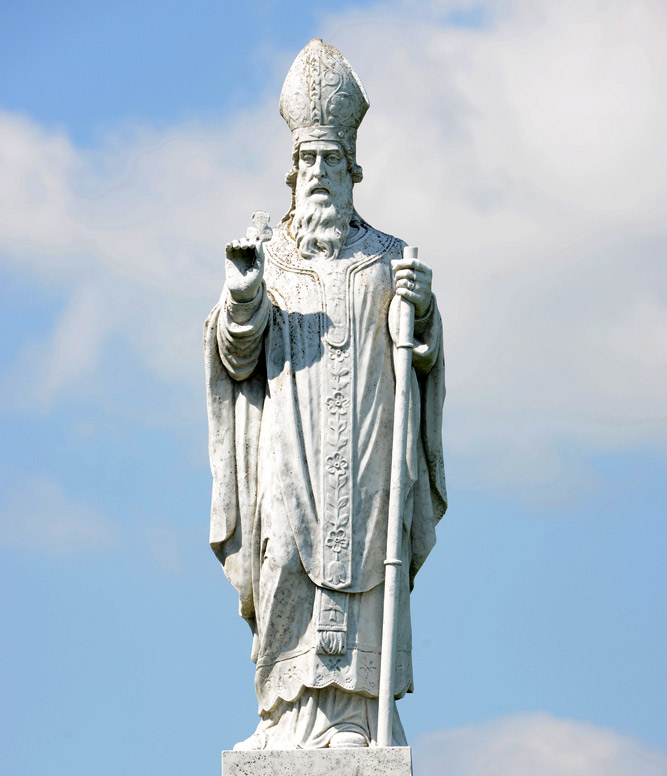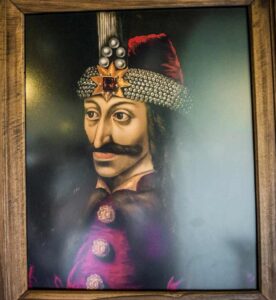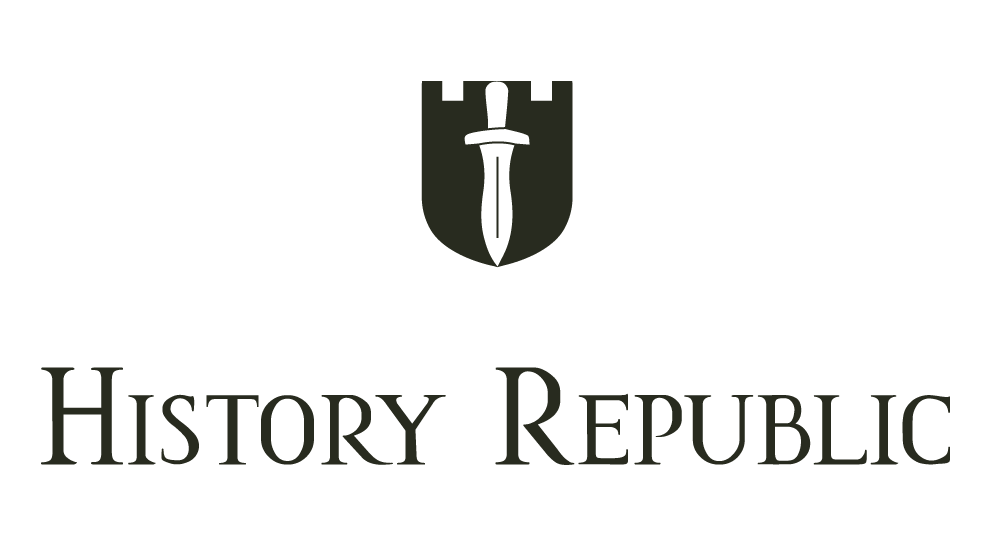Each year on March 17, emerald-green parades wind through city streets, people around the world don shamrocks and “Kiss Me, I’m Irish” T-shirts, and pints of stout are raised in toasts from Dublin to New York to Sydney.
This is Saint Patrick’s Day, a holiday marked by exuberant festivity, cultural pride, and the color green. But behind the revelry and shamrocks stands a surprisingly complex figure: Saint Patrick, a man whose life was shaped by adversity, faith, and an enduring determination to spread Christianity in Ireland.
Yet, even though his name is famous worldwide, the real story of Saint Patrick often remains overshadowed by parades, parties, and the sea of green.
Who was he before the sainthood and legends? Why did he matter so much that he’s still celebrated more than 1,500 years after his death? And how did a solemn day of spiritual observance grow into an international phenomenon?
Let’s step back in time and discover the human story behind the saint.
The World Before Patrick
To understand why Saint Patrick’s mission in Ireland was so monumental, it helps to glance at the backdrop of his era. In the late 4th century and early 5th century, the Roman Empire was struggling to hold its vast territories together.
Political upheaval and invasions from various tribes destabilized regions that once seemed firmly under Roman control. Christianity, once persecuted under certain Roman emperors, had gradually become more accepted—officially recognized and even favored in some parts of the empire.
Now, imagine a young boy growing up in Roman Britain during this shift. The region was connected to the mainland and influenced by Roman customs and laws, but far enough from Rome to have its own unique blend of cultures.
The borderlands were frequently raided by marauders who saw vulnerable settlements as easy targets. Against this uncertain background, Christianity was spreading, but it hadn’t fully taken root in every corner of the island. Pagan beliefs and local religions still thrived, especially on the fringes.
Ireland, for its part, stood apart from Roman rule; Rome never conquered the island. It remained a patchwork of tribal kingdoms, often warring with each other, with leaders who practiced ancient Celtic religions.
Christian missionaries had ventured there, but they made only modest headway. To many outsiders, Ireland was remote, mysterious, and even dangerous. The Celtic peoples there had their own vibrant traditions, epic poetry, and druidic practices.
Enter a boy—likely no older than 16—who would one day become the figure we know as Saint Patrick. He wasn’t born a saint, of course, nor even an ardent believer in his early youth.
But events would soon thrust him into a life-altering journey that not only transformed his personal faith but also reshaped the cultural and spiritual landscape of Ireland.
Early Life and Upbringing
Patrick’s exact date of birth is debated—some say around 385 CE, others place it closer to 390 CE—but most agree he hailed from a Romanized family in Britain.
His father, Calpurnius, was a deacon in the local Christian church, and his grandfather had been a priest. Despite this ecclesiastical lineage, Patrick later admitted that he wasn’t particularly devout as a child. He considered himself a bit careless about religion, more concerned with youthful pursuits than prayer.
Still, growing up in a Christian household during those years meant that faith and scripture would have been part of his daily environment. Family gatherings and community events likely involved readings or sermons. Yet, from Patrick’s own confessions, we know that he didn’t truly embrace these teachings until much later, under dire circumstances.
His environment was relatively stable—but not immune to external threats. Raids by Irish tribes were a constant fear along the British coastline. These raiders, motivated by a desire for slaves and goods, would sail across the Irish Sea to plunder villages and return home with captives who could be sold or put to work.
Though these raids had occurred for years, few could have predicted how drastically one such event would change the course of a young man’s life.
Patrick’s childhood, then, was a mixture of Roman customs, Christian influence, and an undercurrent of danger. Most likely, he never imagined he’d become intimately familiar with Ireland’s interior. But fate had other plans.
Captured and Enslaved
When Patrick was about sixteen years old, Irish raiders struck his community with little warning. In that sudden attack, Patrick was seized, torn away from his family and everything familiar to him. Forced onto a ship bound for Ireland, he became a captive, one among many kidnapped from Britain’s shores.
In Ireland, Patrick was sold to a chieftain or landowner—tradition says he was assigned to herd sheep in the cold, rugged countryside. Miles from home, with no immediate hope of rescue, the teenage Patrick found himself grappling with desperation. Yet in this darkest of times, something remarkable began to happen.
Cut off from his family’s comfort and the routine of daily life, Patrick turned inward. He leaned on the faith he had once taken lightly. Alone in the fields with only sheep for company, Patrick prayed incessantly.
He later wrote in his own confessions that he would pray multiple times a day, finding solace and an inner strength he never knew he had.
Over the years of enslavement, this spiritual awakening took deep root, reshaping him from a carefree youth into a fervent Christian determined to trust in God’s plan—even in the bleakest of circumstances.
This period in captivity lasted about six years. While it was full of hardship, it also laid the spiritual groundwork for the mission that would define the rest of Patrick’s life.
Paradoxically, it was Ireland—his prison—that would become the stage for his greatest achievements once he was free.
Escape and Calling
After six years of servitude, Patrick dreamed of escape. One night, he experienced what he believed to be a divine revelation, prompting him to flee. Slipping away from his master and navigating by faith and cunning, he made his way to a port.
Although the details are sparse, Patrick managed to secure passage on a ship, eventually reaching freedom back in Britain.
But his journey didn’t end with his return home. While many people might have relished the relief of simply returning to “normal” life, Patrick found he was no longer the same person.
The vivid experiences of isolation and spiritual awakening in Ireland weighed on him, and in his dreams, he heard what he described as the “voice of the Irish.” It called him back—beckoning him to bring the Christian faith to the land where he had once been enslaved.
It’s one thing to desire a quiet life after enduring trauma; it’s another to feel compelled to return to the place of your captivity to spread a message of hope. But Patrick was convinced that he had a calling to serve the Irish people.
Determined, he embarked on ecclesiastical training, studying to become a priest. His path likely took him through Gaul (modern-day France) for religious instruction, allowing him to learn the rituals, teachings, and organizational skills he’d need.
When he finally returned to Ireland—this time of his own volition—he did so with a purpose: to convert the Irish, not through force but through understanding and compassion, shaped by his personal experiences among them.
Missionary Work in Ireland
Tradition marks Patrick’s return to Ireland around 432 CE. Equipped with clerical authority and unshakeable faith, he set about converting the Irish from their native Celtic beliefs to Christianity.
At a time when Europe was witnessing the slow collapse of Roman power, Ireland stood largely beyond the empire’s reach. Its political landscape was divided among tribal chiefs and kings who each held sway over their local territories.
Patrick chose a direct approach that blended courage with tact. He would often seek an audience with tribal leaders, hoping to win them over. If a king or chieftain converted, it gave Patrick the protection—and influence—he needed to preach freely in that territory.
But Patrick’s real skill lay in his ability to speak to the hearts of ordinary people. He had lived among them as a shepherd, endured the harshness of Irish weather and terrain, and understood the cultural rhythms that outsiders often missed.
As a result, Patrick’s preaching resonated in a way that earlier missionaries, with less local experience, might have struggled to achieve.
His success wasn’t without challenges. He faced hostility from some druids (the learned class in ancient Celtic cultures), suspicion from local rulers, and the ever-present threat of violence.
Yet Patrick’s confessions mention his tireless resolve, born from his own faith journey. He built churches, established schools, and encouraged literacy—efforts that would outlast his lifetime.
Monasteries became centers of learning, preserving and copying Latin texts and, in time, fostering the distinctive Celtic Christian tradition.
While later stories about Patrick—such as driving out snakes from Ireland (there’s no evidence Ireland ever had snakes) or using the shamrock to explain the Holy Trinity—might be more mythical than factual, they illustrate the deep cultural imprint he left on Ireland.
Even in his lifetime, Patrick’s deeds and compassion shaped the future of a land once seen as wild and unconquerable.
Legacy and Legends
Few historical figures are as intertwined with folklore as Saint Patrick. Over centuries, his reputation grew beyond the real man, merging history with allegory.
The famous tale of him driving out snakes is often interpreted symbolically—the “snakes” representing pagan beliefs or evil forces.
While there’s no natural record of snakes existing in post-glacial Ireland, the story underscores the popular view that Patrick vanquished the “harmful” elements of pagan religion, guiding the country toward Christianity.
Another beloved anecdote is his use of the shamrock—a common three-leafed clover found throughout Ireland—as a visual to explain the Holy Trinity (Father, Son, and Holy Spirit) as three entities in one.
In this symbolic demonstration, each leaf of the shamrock represented one person of the Trinity, while the single stem illustrated that these three persons are still one God. This simple yet effective illustration was especially meaningful in a culture that already associated natural symbols (like plants) with spiritual beliefs.
Though historical records don’t definitively confirm this teaching method, the story reflects Patrick’s broader approach of adapting Christian lessons to Irish traditions and environment. Over time, the shamrock became intertwined with Saint Patrick’s name and work, evolving into a national symbol of Ireland and an emblem closely tied to Irish Christianity.
Whether or not Patrick truly did this in a single, defining moment, the image stuck, and the three-leaf clover became an emblem of Irish Christian identity—and later, Irish identity itself.
Some scholars propose that Patrick’s mission laid the groundwork for Ireland’s remarkable monastic culture, which would become a beacon of scholarship and literacy during the early medieval period.
Irish monks traveled across Europe, establishing monasteries and preserving Christian knowledge, especially when much of the continent was in turmoil after the fall of Rome.
In short, Patrick’s enduring legacy is that of a man who bridged cultural and religious divides, forging a new chapter in Irish history.
Through his compassionate approach, Ireland gradually adopted Christianity in a way that preserved aspects of its cultural identity, fusing new religious beliefs with the traditions of its Celtic heritage.
The Emergence of Saint Patrick’s Day
So how did a missionary, known for humility and devotion, come to have an international holiday in his honor?
Like many saints in early Christianity, Patrick’s life was commemorated on the date of his death, March 17.
Over time, Irish Christians viewed this day as one to remember his contributions—attending church, praying, and sharing stories of his life.
Centuries passed, and as Catholicism solidified in Ireland, Saint Patrick’s Day became an increasingly important religious feast day, where the life of Ireland’s patron saint was central to sermons, prayers, and processions.
During the Middle Ages, smaller parades and feasts might have occurred in local communities, but the day remained largely a religious observance.
The more celebratory elements we recognize today—parades, music, dancing—took shape gradually. Ironically, some of the biggest and most elaborate early parades celebrating Saint Patrick’s Day weren’t in Ireland at all, but in the United States.
Irish immigrants who settled in cities like Boston and New York brought with them a fierce pride in their heritage. Over time, Saint Patrick’s Day became a rallying point for Irish identity in the New World, giving rise to public processions, bagpipe performances, and large social gatherings.
As Irish communities grew and prospered overseas, the holiday evolved into an all-out celebration of Irish culture. It wasn’t just about remembering Patrick as a religious figure—it was about celebrating Ireland, its traditions, and the contributions of the Irish diaspora.
From these gatherings sprang the iconic American parades, which were eventually re-exported back to Ireland, influencing modern festivities in Dublin and other Irish cities.
What began as a solemn remembrance in medieval Ireland is now a cultural juggernaut spanning continents, uniting people of diverse backgrounds who don a bit of green in honor of the Emerald Isle’s patron saint.
Modern-Day Festivities
If Saint Patrick himself could see the global spectacle held in his name, he might be astonished—and perhaps a little puzzled—at how his legacy has transformed.
In modern times, Saint Patrick’s Day is almost synonymous with exuberant parades, vibrant music, and crowded pubs serving Irish beers.
Everywhere you look on March 17, someone is sporting a green shirt, a leprechaun hat, or a cheeky badge proclaiming Irish heritage—or at least a willingness to pretend for the day.
Dublin’s St. Patrick’s Festival is a multi-day affair featuring concerts, cultural events, and a parade that draws thousands of spectators. The capital city bursts with dance troupes, marching bands, and floats celebrating Irish myth and history.
Meanwhile, in cities like New York, the Saint Patrick’s Day Parade is one of the largest and oldest in the world, winding for hours through streets lined with Irish flags and spirited onlookers. Towns across the globe—whether in Canada, Australia, Argentina, or beyond—host their own parades, each putting a unique cultural spin on the celebration.
Beyond parades, the day is filled with music sessions in local pubs—often featuring Irish folk songs on fiddles, flutes, and bodhráns (a traditional Irish drum).
Food, too, plays a part in the festivities: corned beef and cabbage, Irish stew, and soda bread often appear on menus. Though these items aren’t always entirely authentic to historical Irish cuisine, they have become emblematic of Irish-American traditions.
What unites these global parties is a sense of celebration—of Irish heritage, of community, and of the enduring story of a boy who overcame enslavement to become the spiritual shepherd of a nation.
For many, it’s both a solemn homage and a joyous expression of cultural pride.
Why We Celebrate
Delving past the greenery and Guinness, the core of why we celebrate Saint Patrick’s Day can be understood on two levels: historical and cultural.
- Historical Significance: Patrick’s life story resonates across centuries because it’s a narrative of transformation, resilience, and empathy. Captured in his teens, he experienced the trials of slavery, only to find a profound faith that guided him back to the land of his captivity. In an era where conquest was often synonymous with brute force, Patrick chose dialogue, compassion, and adaptation.
He established monasteries that became spiritual and educational hubs, influencing Ireland’s trajectory for generations. Honoring Saint Patrick means remembering the man who, through quiet determination, shaped an entire people’s religious landscape.
- Cultural Celebration: Over time, the day evolved into an emblem of Irish identity, not only for those on the island but for millions of descendants worldwide. For immigrant communities, Saint Patrick’s Day became a statement of unity—a day to celebrate roots, remember ancestors who left Ireland in search of a better life, and showcase pride in heritage.
Today, those traditions extend to anyone who wishes to partake, emphasizing inclusivity, fun, and a spirit of global fellowship.
While modern festivities can sometimes overshadow the day’s sacred origins, many still use March 17 as a moment to reflect on themes of faith, perseverance, and cultural solidarity.
In essence, we celebrate Saint Patrick’s Day both to honor a historical figure’s monumental impact and to revel in the enduring cultural tapestry he helped shape.
Lessons from Saint Patrick’s Life
Amidst the parades and parties, it’s easy to forget that Saint Patrick’s life offers enduring lessons about resilience, compassion, and adaptability. Here are a few takeaways that remain relevant:
- Overcoming Hardship: Patrick’s adolescence was stolen by raiders, and he lived through a grim period of enslavement. Instead of letting bitterness define him, he transformed adversity into a profound spiritual resolve.
- Empathy in Action: Patrick returned to the very place of his captivity, not seeking retribution but aiming to build bridges. His familiarity with Irish language and customs helped him find common ground.
- Persistence and Dedication: Converting an entire island and establishing churches and schools was no small feat. Patrick faced opposition from druids, local chiefs, and skeptics, yet he pressed on, guided by steadfast conviction.
- Cultural Fusion: Rather than erasing local traditions, Patrick worked with existing practices, reinterpreting symbols like the shamrock to convey Christian ideals. His approach was less about conquest, more about mutual understanding.
These values—resilience, empathy, and cultural respect—ring as true in the modern business world, social advocacy, or personal life as they did in 5th-century Ireland.
Even for those who don’t share Patrick’s religious viewpoint, there’s wisdom to be found in his journey from captive to saint.
Bringing It All Together: The Heart of the Holiday
Saint Patrick’s Day is many things to many people. For some, it’s primarily a religious occasion—a day of prayer and reflection on the patron saint who brought Christianity to Ireland.
For others, it’s a cultural festival celebrating music, dance, and the rollicking energy that’s often associated with Irish communities around the globe. And for still others, it’s simply a chance to wear green, share laughs with friends, and raise a glass in the spirit of good cheer.
The beauty of this holiday is its inclusivity. Over centuries, Saint Patrick’s Day evolved from a local, faith-based remembrance into a worldwide celebration that embraces multiple layers of heritage, from Irish-Americans in New York to Irish-Argentinians in Buenos Aires to diaspora communities spanning continents.
Even non-Irish folks join in wholeheartedly, seeing in the festivities an invitation to celebrate unity, fun, and perhaps a bit of Irish charm.
At its core, though, what we remember each March 17 is the power of one determined individual who, guided by faith and a genuine desire to uplift others, shaped the identity of a nation.
In honoring Saint Patrick, we honor the timeless idea that hope, compassion, and perseverance can indeed change the world—even if that world starts as a small island off the northwestern shore of Europe.
Conclusion
Saint Patrick is more than just a name splashed across pubs or pinned onto paper shamrocks.
He was a real person with a profound personal journey—kidnapped in youth, spiritually reborn in hardship, and ultimately driven by compassion to return to the land that once imprisoned him.
His work in Ireland laid the foundations of a faith tradition that thrived, carrying echoes of Celtic culture into monastic centers that would preserve learning through some of Europe’s darkest eras.
Over the centuries, Patrick’s memory grew into legend, woven together with Irish folklore and national pride. From a holy day commemorating his death, Saint Patrick’s Day blossomed into a worldwide celebration of Irish heritage, unity, and joy.
Today, the festivities are as diverse as the communities that observe them—some focusing on solemn church services, others on lively parades and hearty feasts.
Yet, through all these expressions, a common thread persists: the story of a humble shepherd, returned as a shepherd of souls, uniting faith and culture in a way that still resonates across the globe.
So, whether you’re Irish by blood, Irish by association, or just Irish at heart on March 17, take a moment between sips of tea (or stout) to remember the man behind the myth—a saint whose life continues to inspire and bring people together, centuries after his final prayer on Irish soil.





